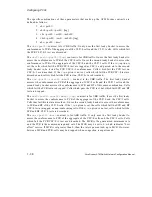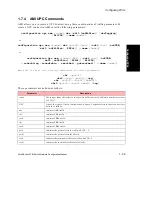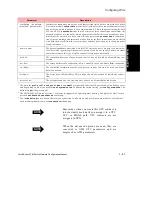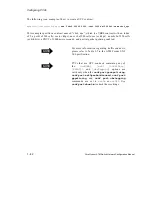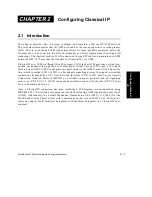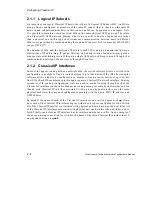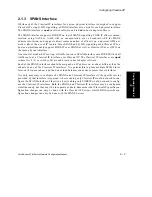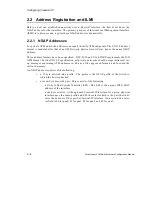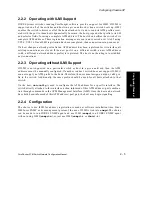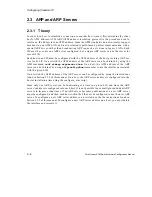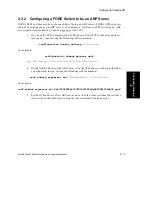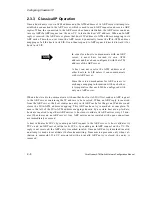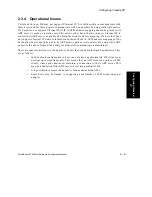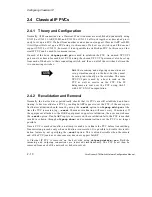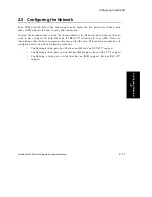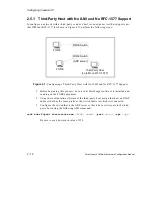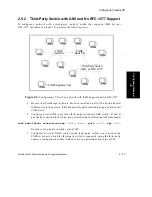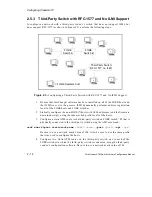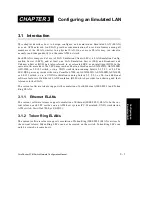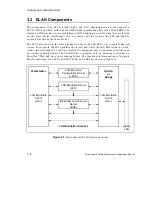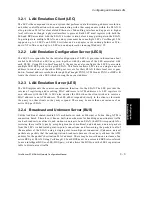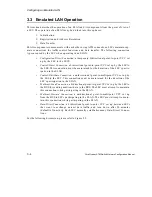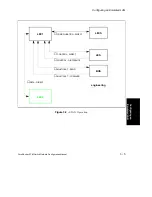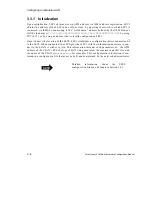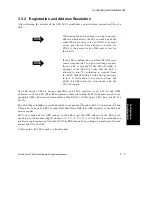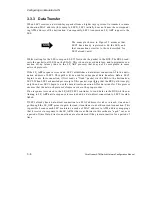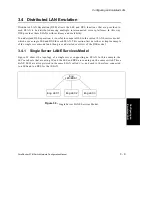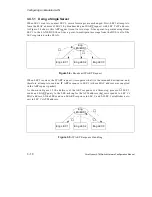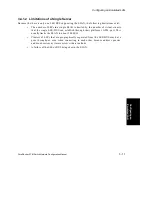
2 - 10
ForeRunner
ATM Switch Network Configuration Manual
Configuring Classical IP
2.4 Classical IP PVCs
2.4.1 Theory and Configuration
Normally, ATM connections in a Classical IP environment are established dynamically using
UNI 3.0 or UNI 3.1. ARP, ILMI, and UNI 3.0 or UNI 3.1 all work together as described previ-
ously to set up an SVC. If a host from another vendor does not support Classical ARP or ILMI,
it is still possible to set up an SVC using work-arounds. If a host or a switch in an LIS does not
support UNI 3.0 or UNI 3.1, however, it is not possible to establish an SVC. In this case, a Clas-
sical IP PVC can be used for communication.
On each of the hosts,
cliparp
add
-pvc
is used to establish the PVC. An unused VPI/VCI
pair must be chosen for each host. PVCs using the chosen VPI/VCI pairs must also be set up
from each of the hosts to their connecting switch, and then on all of the switches between the
two connecting switches.
NOTE
Both the incoming and outgoing connections are
set up simultaneously on the host, but they must
be set up individually on the switches. The same
VPI/VCI pair is used by a host to send on the
PVC as well as receive on the PVC. The IP
datagrams are sent over the PVC using AAL5
with LLC/SNAP encapsulation.
2.4.2 Revalidation and Removal
Normally, the device driver periodically checks that its PVCs are still established and func-
tioning. A host revalidates a PVC by sending InARP requests over the PVC, if the user speci-
fies that revalidation should occur by using the
-reval
option to
cliparp
add
-pvc
at the
time the PVC is created (e.g.,
-reval
10 means revalidation will occur every 10 minutes). If
the equipment attached to the FORE equipment supports revalidation, the user must choose
the
-reval
option. If an InARP reply is not received, the revalidation fails, the PVC is marked
invalid (as shown through
cliparp
show
), and communication over the PVC is no longer
possible.
Once a PVC is marked invalid, an attempt is made to validate the PVC before transmitting.
Transmission proceeds only when validation is successful. It is possible to disable this revali-
dation feature by not specifying the
-reval
option. This is often desirable when the remote
end of the PVC (such as a video camera) does not support InARP.
A Classical IP PVC is removed on the host side using
cliparp
delete
-pvc
. Both the
incoming and outgoing connections are removed simultaneously. The PVC must then be
removed from each of the network switches involved.
Summary of Contents for forerunner series
Page 6: ......
Page 16: ...TOC 10 ForeRunner ATM Switch Network Configuration Manual Table of Contents ...
Page 20: ...LOF 4 ForeRunner ATM Switch Network Configuration Manual List of Figures ...
Page 22: ...LOT 2 ForeRunner ATM Switch Network Configuration Manual List of Tables ...
Page 30: ...viii ForeRunner ATM Switch Network Configuration Manual Preface ...
Page 144: ...3 58 ForeRunner ATM Switch Network Configuration Manual Configuring an Emulated LAN ...
Page 180: ...6 12 ForeRunner ATM Switch Network Configuration Manual ATM Forum PNNI ...
Page 220: ...9 6 ForeRunner ATM Switch Network Configuration Manual Configuring Timing ...
Page 300: ...D 24 ForeRunner ATM Switch Network Configuration Manual Configuring FramePlus Modules ...
Page 308: ...Acronyms 8 ForeRunner ATM Switch Network Configuration Manual Acronyms ...
Page 346: ...Glossary 38 ForeRunner ATM Switch Network Configuration Manual Glossary ...
Page 352: ...Index 6 ForeRunner ATM Switch Network Configuration Manual Index ...

